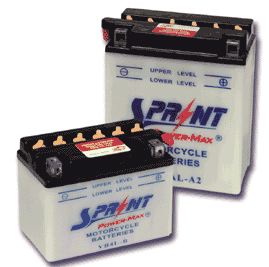
Charging method for both 6v and 12v conventional motorcycle batteries.
Conventional/lead acid (also know as wet or flooded cell) batteries normally have opaque, semi see through sides and a row of removable plastic stoppers in the top (usually yellow or red in colour, there will be 6 stoppers in the top of a 12 volt battery and 3 stoppers in the top of a 6 volt battery).
The batteries usually start with the code YB, CB, GB, DB, EB (e.g. YB9-B, CB9-B etc), 12N or 6N (e.g. 12N24-3 or 6N6-3B).
1) The 1st step for lead acid motorcycle battery charging is to remove the packing & yellow stoppers from the top of the battery. Remove the cap from the end of the breather nipple located at the top on the side of the battery.
2) Fill each of the holes in the top of the battery with battery acid up to the upper level mark on the front of the battery (do not replace the yellow stoppers yet)
3) Place the stoppers loosely in the holes at the top of the battery (this prevents dirt and debris falling into the battery) and leave to settle for 1 hour.
After 1 hour, if the acid level has dropped below the upper level mark, top up the battery with battery acid the upper level mark
4) Charge the battery for at least 4 to 6 hours (preferably overnight) with a motorcycle battery charger
5) After charging, disconnect the battery from the charger & leave to settle for 1 hour
6) Re check the battery acid level (make sure it is up to the upper level mark) & top up the acid levels if required
7) Securely replace the yellow stoppers into the holes in the top of the battery
8) The battery is now filled & charged & ready for use (when connecting to a motorbike/scooter, always connect the positive (+) terminal first)
Please remember: Battery acid (or electrolyte) should ONLY be used for initially filling the battery.
If the acid level drops below the upper level mark and you need to top up the battery at a later date, you should use distilled water to top up the battery.
Disclaimer:
To keep this page as a free resource for people to use, there are affiliate links (mainly Amazon) throughout the article. These affiliate links help maintain the cost of running this blog (basically, if you visit Amazon through one of the links and buy something, we make a few pence!).

Leave a Reply